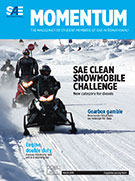Magazine

Automotive Engineering: September 2017
2017-09-01
New vision @ Gentex Creating a vital ADAS partner through home-grown R&D and manufacturing in (of all places) western Michigan. Positioning for hybrid growth BorgWarner "modularizes" to provide OEMs optimal electrified-driveline flexibility. Editorial: Beleaguered diesel could use a break-or a breakthrough SAE Standards News Kickoff to begin testing program to validate SAE J2954 wireless charging Recommended Practice Supplier Eye Will you be an active participant or passive bystander? The Navigator For future vehicles, communication equals trust Tenneco readies new semi-active digital suspension for 2020 New 90-degree turbo V6 leads Audi's hybridization blitz GKN using modular control algorithms for added systems integration U of M students engineer new autonomous shuttle system Jaguar's 2018 E-Pace shares Land Rover bones Ford pumps powertrains for 2018 F-150 2018 Subaru Crosstrek moves to new global platform Nissan's Ponz Pandikithura on EV lifecycle value










